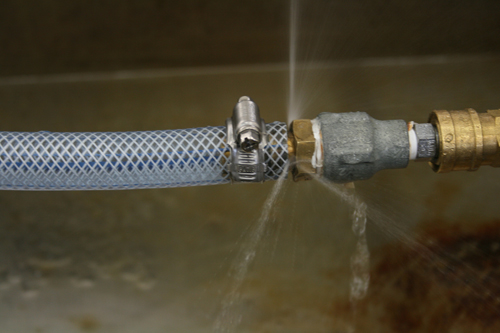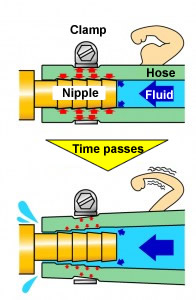Hose and Coupling Knowledge Base
If You Register to Become a Web Member, We Will Send You the Latest Information on Hoses and Coupling.
Causes & Solutions for Leaks & Disconnections

Has this ever happened to you?
The hose is connected correctly to the coupling, but then at some point it starts leaking or the hose comes off? These problems can be caused by a number of different things. Here, we look at some solutions for these problems.
In Topic 001, we talked about why hoses become stiffer with use. This stiffness is a major cause of hoses leaking and becoming disconnected.
When attaching a hose to a coupling, the hose is placed on a nipple that is slightly larger than the inner diameter of the hose. When this happens, the hose diameter is widened slightly, and the natural tendency of the hose to return to its original size provides a gripping force.
As the hose grows stiffer over long use, this elastic shrinking force weakens so that the hose can no longer perform normally. This leads to leaks and disconnections.
This applies not only to hoses connected to nipples, but to cases in which a clamp is used as well. Even when the initial attachment is a perfect, leaks and disconnections may occur over time.
Here are some ways to prevent these problems:
1. select a hose appropriate for your use and that resists becoming stiff, 2. perform careful maintenance, including regular re-tightening of hoses, and 3. check hoses regularly and replace them when they begin to become stiff.

Hoses leak when they become stiff
Archive
How to Cut Steel-Wire-Reinforced PVC Hose
Does Electricity Conservation Increase Condensation?
Why Do Hoses Leak & Disconnect?
Can PVC & Other Plastic Hoses Be Used for Fuel Gas & Kerosene?
How to Read Catalog Specifications, Part 4 – Are Hose Sizes Random?
How to Read Catalog Specifications, Part 3 – Minimum Bend Radius
Beware of Static Electricity on Hoses
How to Read Catalog Specifications, Part 2 – Negative Pressure+B10
About REACH, RoHS, Endocrine Disruptor & the Food Sanitation Act
How to Read Catalog Specifications, Part 1 – Use Pressure
How to Avoid Damage Caused by Ultraviolet Rays
The Dangers of Hose Condensation
Why Transparent Hoses Become Cloudy
Leaks & Disconnections Due to Mismatched Couplings & Hoses
Causes & Solutions for Leaks & Disconnections
The Benefits of the Right Hose for the Situation (2)









